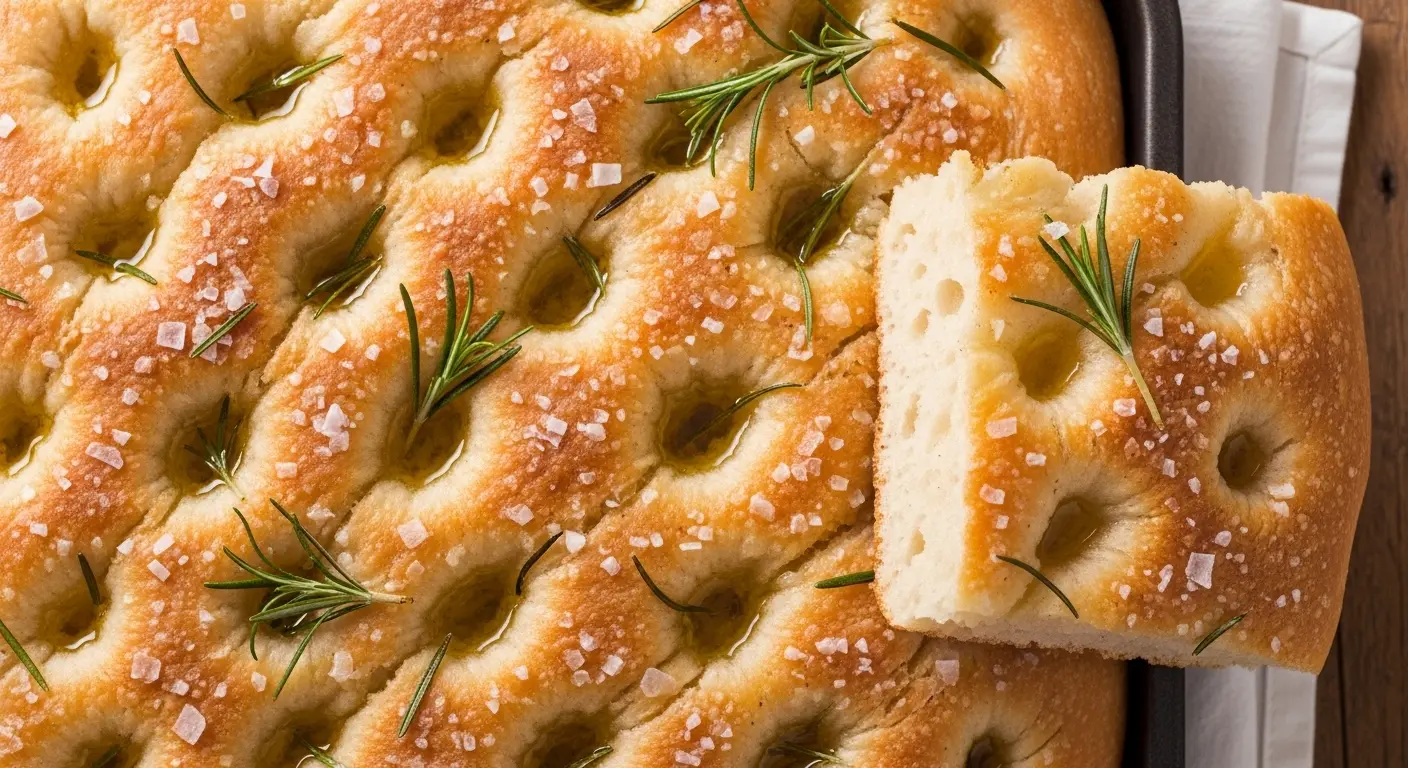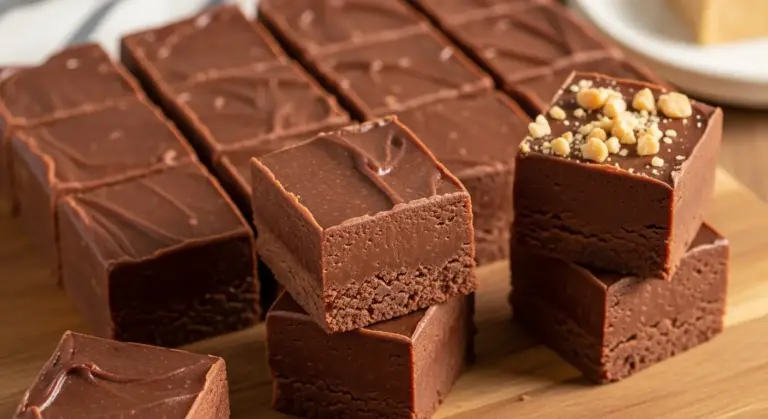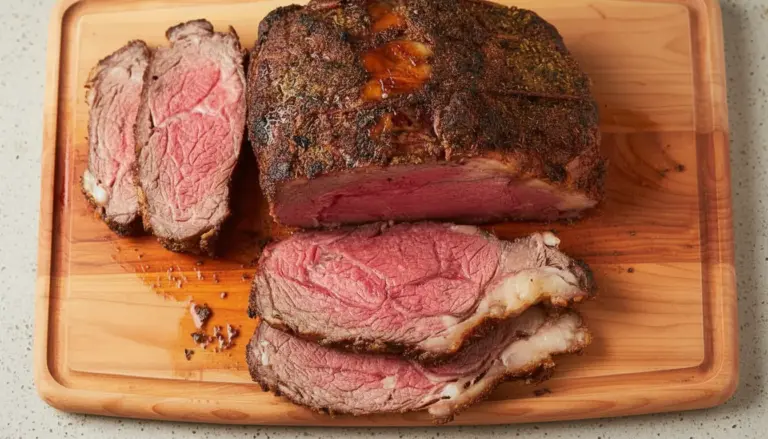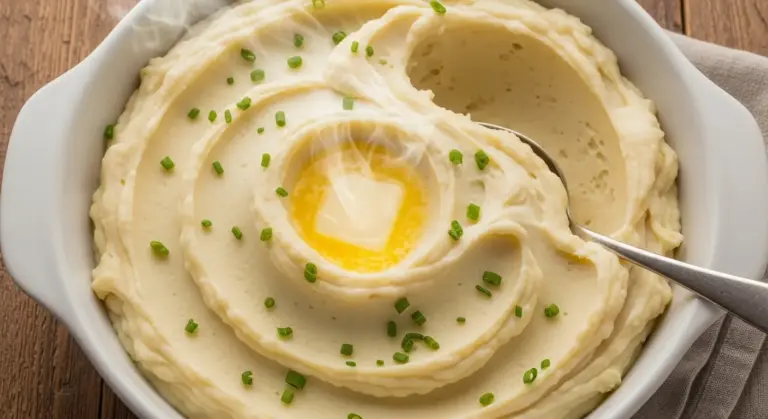I never thought I’d become the person who keeps a sourdough starter alive like it’s a pet, but here we are. After months of feeding my starter and making loaf after loaf of bread, I stumbled upon this sourdough focaccia recipe that completely changed my baking routine.
The beauty of using sourdough starter in focaccia is that it adds this incredible depth of flavor that regular yeast just can’t match. The tangy notes from the fermentation complement the olive oil and herbs perfectly.
I still remember my first attempt at this recipe. I was nervous about using my precious starter for something other than traditional bread. But when I pulled that golden, dimpled focaccia from the oven, with pools of olive oil glistening on top, I knew I’d found something special.
My kids now request this sourdough focaccia at least twice a week. They love tearing off chunks and dipping them into marinara sauce or using them for sandwiches.
The process might seem intimidating if you’re new to sourdough, but trust me when I say this is actually one of the easier sourdough recipes. No fancy shaping skills required, just dimple and bake.
| Quick Recipe Summary | |
|---|---|
| Prep Time | 20 minutes (plus 8-12 hours fermentation) |
| Cook Time | 25 minutes |
| Total Time | 45 minutes (active time) |
| Servings | 12 pieces |
| Difficulty Level | Medium |
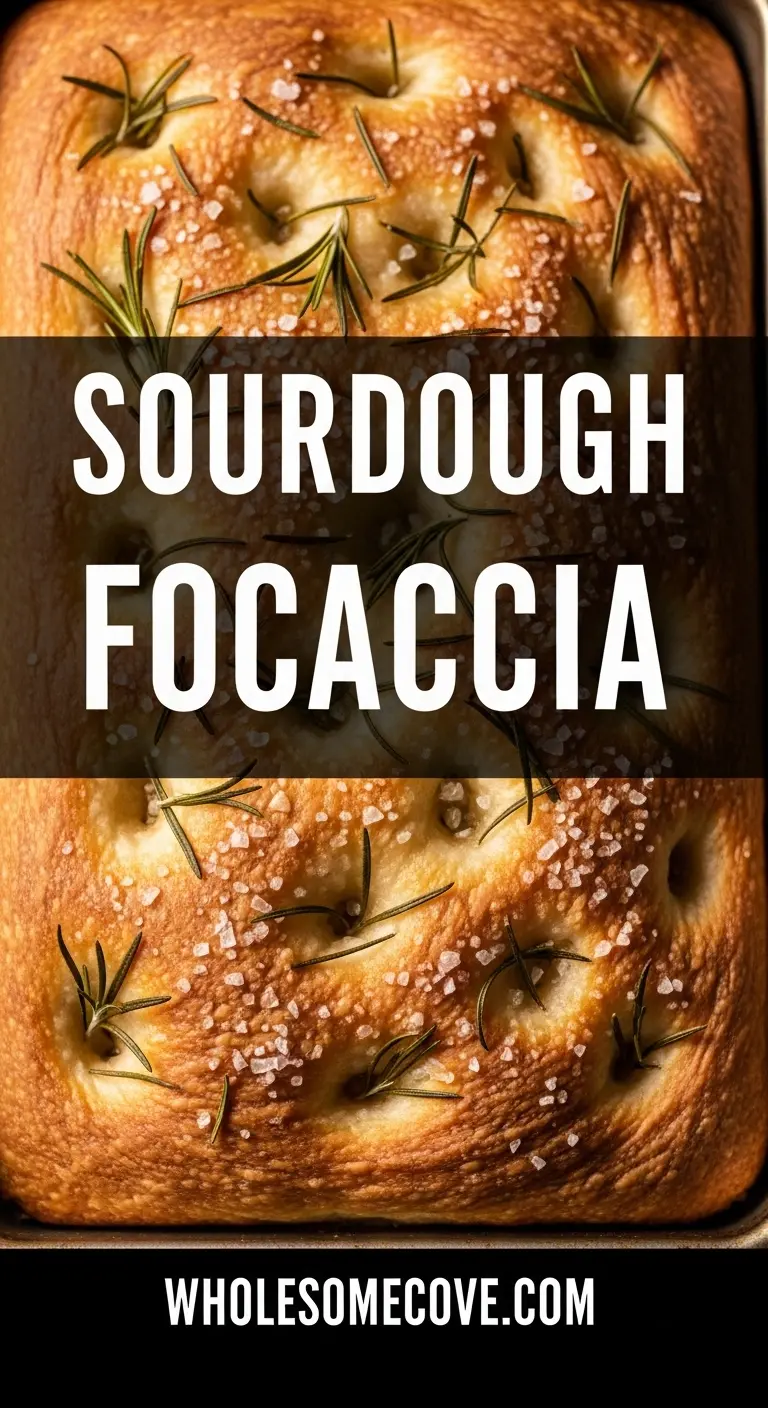
Why You’ll Love This Sourdough Focaccia Recipe
This sourdough focaccia combines the best of both worlds: the complex flavor of traditional sourdough with the simplicity of focaccia’s no-knead method. You get all that tangy goodness without the stress of shaping a perfect loaf.
The texture is absolutely divine. Crispy, golden bottom from the generous amount of olive oil, pillowy soft interior with those characteristic air pockets, and a top that’s both crispy and tender at the same time.
Here’s what makes this recipe stand out:
- Minimal hands-on time: Most of the work is just waiting for the dough to ferment, which fits perfectly into a busy schedule
- No kneading required: The stretch and fold method does all the work for you
- Incredibly versatile: Top it with anything from simple sea salt and rosemary to caramelized onions and cheese
- Uses leftover sourdough discard or active starter: Both work beautifully in this recipe
- Foolproof results: The forgiving nature of focaccia means even beginners get beautiful results
- Perfect for meal prep: Makes amazing sandwich bread, toast, or serves as a crowd-pleasing appetizer
I learned this from my mother, who perfected her air fryer french toast recipe using day-old focaccia.
Ingredients
This recipe keeps things simple with pantry staples and your trusty sourdough starter. The key is using high-quality ingredients, especially the olive oil, since it really shines through in the final product.
- 100g (½ cup) active sourdough starter: fed and bubbly, or use unfed discard and add an extra hour or two to fermentation time
- 350g (1½ cups) warm water: around 90-100°F (32-38°C), not hot or it will kill the starter’s activity
- 500g (4 cups) bread flour: higher protein content creates better structure and chew
- 10g (2 teaspoons) fine sea salt: I prefer fine salt as it dissolves more evenly
- 30ml (2 tablespoons) extra virgin olive oil: for the dough, plus more for the pan and topping
- Fresh rosemary sprigs: about 2-3 tablespoons chopped, or use other herbs like thyme or oregano
- Flaky sea salt: for finishing, Maldon sea salt is my go-to
You might also enjoy: Same Day Sourdough Bread
Kitchen Equipment Needed
You don’t need fancy equipment for this recipe, but a few key items will make your life much easier and give you better results.
- Large mixing bowl: Glass or ceramic works best as they don’t react with the acidic starter
- 9×13 inch baking pan: I use a metal pan for the crispiest bottom
- Kitchen scale: Essential for accurate measurements in sourdough baking
- Plastic wrap or damp kitchen towel: To cover the dough during fermentation
- Bench scraper: Helpful for the stretch and fold technique, though your hands work fine too
- Small bowl for olive oil: Makes it easier to drizzle and spread
Recommended Products for This Recipe
After making this focaccia countless times, I’ve found a few products that genuinely make a difference in the final result. These aren’t just nice-to-haves; they actually improve the texture, flavor, and overall success of the recipe.
1. King Arthur Bread Flour
The protein content in this flour is perfectly balanced for focaccia, giving you that ideal chewy texture without being too dense. I’ve tried cheaper brands, and the difference in rise and structure is noticeable. This flour creates those beautiful air pockets you want in great focaccia.
2. California Olive Ranch Extra Virgin Olive Oil
Since olive oil is such a prominent flavor in focaccia, using a quality one matters. This California olive oil has a buttery, slightly peppery taste that doesn’t overpower the sourdough tang. I use it both in the dough and for drizzling on top.
3. USA Pan Bakeware Rectangular Baking Pan
This heavy-gauge aluminized steel pan distributes heat so evenly that you get that perfectly crispy, golden bottom every single time. The nonstick coating also means your focaccia releases beautifully without tearing. It’s been my go-to for three years and still looks brand new.
4. Maldon Sea Salt Flakes
This is the finishing touch that takes focaccia from good to restaurant-quality. The delicate, crunchy flakes dissolve slightly into the olive oil on top, creating pockets of salty goodness. Regular table salt just doesn’t give you the same textural contrast.
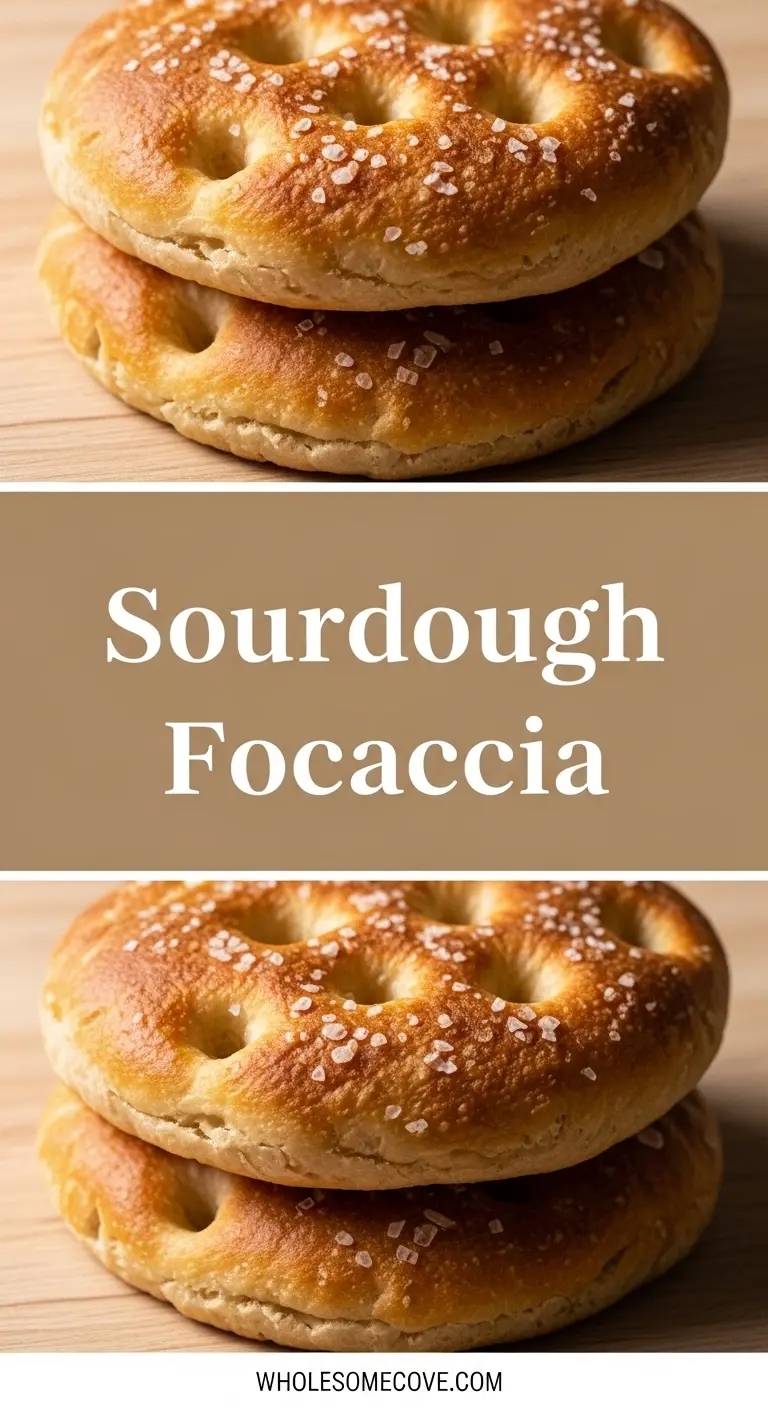
Step-by-Step Instructions: How to Make Sourdough Focaccia
Making sourdough focaccia is a relaxed process that fits beautifully into your day. The key is planning ahead for the fermentation time, but the actual hands-on work is minimal and forgiving.
1. Mix the Dough
- In your large mixing bowl, combine the active sourdough starter and warm water, stirring until the starter is mostly dissolved and the mixture looks cloudy
- Add the bread flour and mix with your hands or a wooden spoon until no dry flour remains and you have a shaggy, sticky dough
- Let this mixture rest for 30 minutes, which allows the flour to fully hydrate and makes the salt easier to incorporate
- After the rest, sprinkle the fine sea salt over the dough and drizzle with 2 tablespoons of olive oil
- Use your hands to dimple and squeeze the dough, incorporating the salt and oil throughout until evenly distributed
2. Bulk Fermentation with Stretch and Folds
- Cover the bowl with plastic wrap or a damp towel and let it rest for 30 minutes at room temperature (ideally 70-75°F or 21-24°C)
- Perform your first stretch and fold by wetting your hands, grasping one side of the dough, stretching it up, and folding it over to the opposite side
- Rotate the bowl 90 degrees and repeat this stretch and fold three more times, working your way around the dough
- Cover again and rest for another 30 minutes, then repeat the stretch and fold process
- Complete a total of 3-4 sets of stretch and folds over 2 hours, resting 30 minutes between each set
- After the final stretch and fold, cover tightly and let the dough ferment at room temperature for 6-10 hours, or refrigerate for 8-12 hours for deeper flavor development
Another favorite: Fresh Milled Flour Bread
3. Prepare the Baking Pan
- Pour about 3 tablespoons of extra virgin olive oil into your 9×13 inch baking pan, tilting to coat the bottom and sides completely
- The generous oil creates that signature crispy bottom and prevents sticking
- Use your fingers to make sure every corner is well-oiled
4. Shape the Focaccia
- Gently coax the fermented dough out of the bowl and into your prepared pan, being careful not to deflate it too much
- Let the dough rest in the pan for 15-20 minutes to relax, which makes it easier to stretch
- Using oiled fingers, gently press and stretch the dough toward the corners of the pan
- If the dough resists and springs back, let it rest another 10 minutes and try again
- Continue until the dough fills most of the pan, though it doesn’t need to reach every corner perfectly
- Cover loosely and let the dough proof for 45-60 minutes until it looks puffy and jiggles slightly when you shake the pan
Read Also: Einkorn Bread Recipe
5. Dimple and Top
- Preheat your oven to 425°F (220°C) while the dough finishes its final proof
- Drizzle about 2 tablespoons of olive oil over the surface of the proofed dough
- Using all your fingertips, firmly press straight down into the dough, creating deep dimples all over the surface
- Don’t be shy here; really push down to create those characteristic focaccia divots that will hold pools of olive oil
- Press fresh rosemary sprigs or chopped rosemary into the dough
- Sprinkle generously with flaky sea salt
6. Bake to Golden Perfection
- Place the pan on the middle rack of your preheated oven
- Bake for 20-25 minutes until the top is deeply golden brown and the edges are crispy
- The focaccia should sound hollow when you tap the bottom
- If the top is browning too quickly but the bread isn’t done, tent it loosely with foil for the last 5 minutes
- Remove from the oven and drizzle with another tablespoon of olive oil while still hot
- Let it cool in the pan for 5 minutes, then transfer to a wire rack
7. Cool and Serve
- Allow the focaccia to cool for at least 10-15 minutes before slicing
- This resting time lets the crumb set properly and makes slicing cleaner
- Cut into squares or rectangles using a sharp serrated knife
- Serve warm or at room temperature

Tips for The Best Sourdough Focaccia
These tips come from many batches of trial and error. Following them will help you avoid the mistakes I made early on and get perfect focaccia every time.
- Temperature matters: Keep your dough in a warm spot (70-75°F) for optimal fermentation; too cold and it will take forever, too hot and it may over-ferment
- Don’t skimp on the oil: The generous amount of olive oil isn’t just for flavor; it creates that crispy, golden bottom and keeps the focaccia moist
- Use active starter for faster results: Fed, bubbly starter will ferment in 6-8 hours at room temperature, while discard may take 10-12 hours
- The windowpane test isn’t necessary: Unlike traditional bread, focaccia dough should remain quite wet and sticky; don’t add extra flour
- Dimple deeply: Really push your fingers down to the bottom of the pan when dimpling; shallow dimples won’t create those signature oil pools
- Watch for over-proofing: If your dough becomes overly slack and spreads too thin in the pan, it may be over-proofed; reduce fermentation time next batch
- Customize your herbs: Fresh herbs work best, but if using dried, reduce the amount by half as dried herbs are more concentrated
- Let the dough rest: If the dough keeps springing back when you try to stretch it in the pan, give it 10-15 minutes to relax
- Invest in a kitchen scale: Volume measurements for flour can vary significantly; weighing gives consistent results every time
- Save some for later: Focaccia freezes beautifully; wrap cooled pieces tightly and freeze for up to 3 months
For a lighter option, try: Healthy Pizza Dough
Serving Suggestions
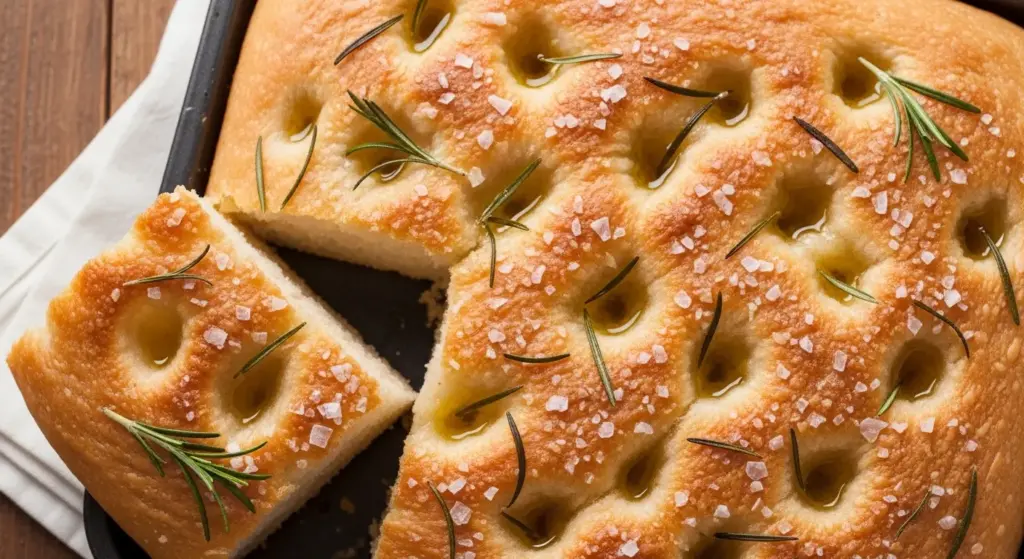
Sourdough focaccia is incredibly versatile and works for almost any meal or occasion. The tangy flavor and sturdy texture make it perfect for both simple and elaborate preparations.
Here are my favorite ways to serve it:
- As sandwich bread: Slice horizontally and fill with mozzarella, tomatoes, and basil for an incredible caprese sandwich
- With soup: Tear off chunks for dipping into creamy tomato basil soup or easy chicken noodle soup
- For breakfast: Toast slices and top with mashed avocado, poached eggs, and everything bagel seasoning
- As an appetizer: Cut into small squares and serve with marinara sauce for dipping
- Alongside pasta: Perfect companion to lasagna or chicken parmesan
- With charcuterie: Add to a cheese and charcuterie board for texture contrast
- Topped with burrata: Drizzle with balsamic glaze and fresh tomatoes for an elegant appetizer
- For bruschetta: Toast and top with healthy bruschetta mixture
Variations of Sourdough Focaccia
Once you master the basic recipe, the variations are endless. I love experimenting with different toppings and mix-ins to keep things interesting.
- Garlic and herb: Mix minced garlic into the dough and top with a blend of fresh basil, oregano, and thyme
- Caramelized onion and thyme: Slowly cook sliced onions until golden and sweet, then scatter over the top before baking
- Cherry tomato and olive: Press halved cherry tomatoes and pitted olives into the dimples for a Mediterranean twist
- Potato and rosemary: Thinly slice small potatoes and arrange them over the dough before the final proof
- Cheese focaccia: Sprinkle shredded mozzarella or parmesan over the top during the last 5 minutes of baking
- Za’atar focaccia: Replace rosemary with za’atar spice blend and top with sesame seeds
- Grape focaccia: Press halved red grapes into the dough for a sweet-savory Italian classic called focaccia all’uva
- Everything bagel: Top with everything bagel seasoning instead of plain salt for a fun twist
- Pesto swirl: Drizzle healthy homemade pesto over the dough before baking and swirl with a knife
- Whole wheat: Replace up to half the bread flour with whole wheat flour for a heartier, nuttier flavor
Read Also: Cracklin Bread Recipe
Storage and Reheating
Proper storage keeps your focaccia fresh and delicious for days. The good news is that focaccia actually ages beautifully and makes fantastic toast even when it’s a few days old.
- Room temperature: Store in an airtight container or wrapped in foil for up to 3 days
- Refrigeration: Not recommended as it dries out the bread faster
- Freezing: Wrap individual portions tightly in plastic wrap, then place in a freezer bag; freezes for up to 3 months
- Reheating from frozen: Let thaw at room temperature for an hour, then warm in a 350°F (175°C) oven for 5-10 minutes
- Refreshing day-old focaccia: Sprinkle lightly with water and heat in a 350°F (175°C) oven for 5-7 minutes to restore crispness
- Making croutons: Cut stale focaccia into cubes, toss with olive oil and herbs, and bake at 375°F (190°C) until crispy
- For sandwiches: Slice and store in portions so you can grab pieces as needed without exposing the whole loaf to air
- Toasting tip: Slice and toast in a dry skillet or toaster oven to bring back the crispy texture
Nutritional Facts
Per serving (1 of 12 pieces):
- Calories: 185
- Total Fat: 6g
- Saturated Fat: 1g
- Cholesterol: 0mg
- Sodium: 390mg
- Total Carbohydrates: 28g
- Dietary Fiber: 1g
- Sugars: 0g
- Protein: 5g
Note: Nutritional values are approximate and will vary based on specific ingredients used and portion sizes. The values above are based on the basic recipe without additional toppings.
Another favorite: Healthy Banana Bread
Health Benefits of Key Ingredients
Beyond being absolutely delicious, sourdough focaccia actually offers some nutritional benefits, especially compared to regular bread made with commercial yeast.
The key health benefits include:
- Sourdough fermentation: The long fermentation process breaks down gluten and phytic acid, making nutrients more bioavailable and the bread easier to digest for many people
- Lower glycemic index: Sourdough has a lower glycemic index than regular bread, meaning it causes a slower, more gradual rise in blood sugar levels
- Probiotic benefits: While most beneficial bacteria die during baking, the fermentation process creates compounds that support gut health
- Extra virgin olive oil: Rich in heart-healthy monounsaturated fats and antioxidants like polyphenols that fight inflammation
- Whole grain option: Using whole wheat flour adds fiber, B vitamins, iron, and other essential minerals
- Fresh herbs: Rosemary contains antioxidants and anti-inflammatory compounds, plus it adds flavor without extra calories or sodium
- Improved mineral absorption: The fermentation process reduces phytic acid, allowing your body to absorb more iron, zinc, and magnesium from the flour
- Natural preservation: The acidity from fermentation acts as a natural preservative, so you don’t need any additives
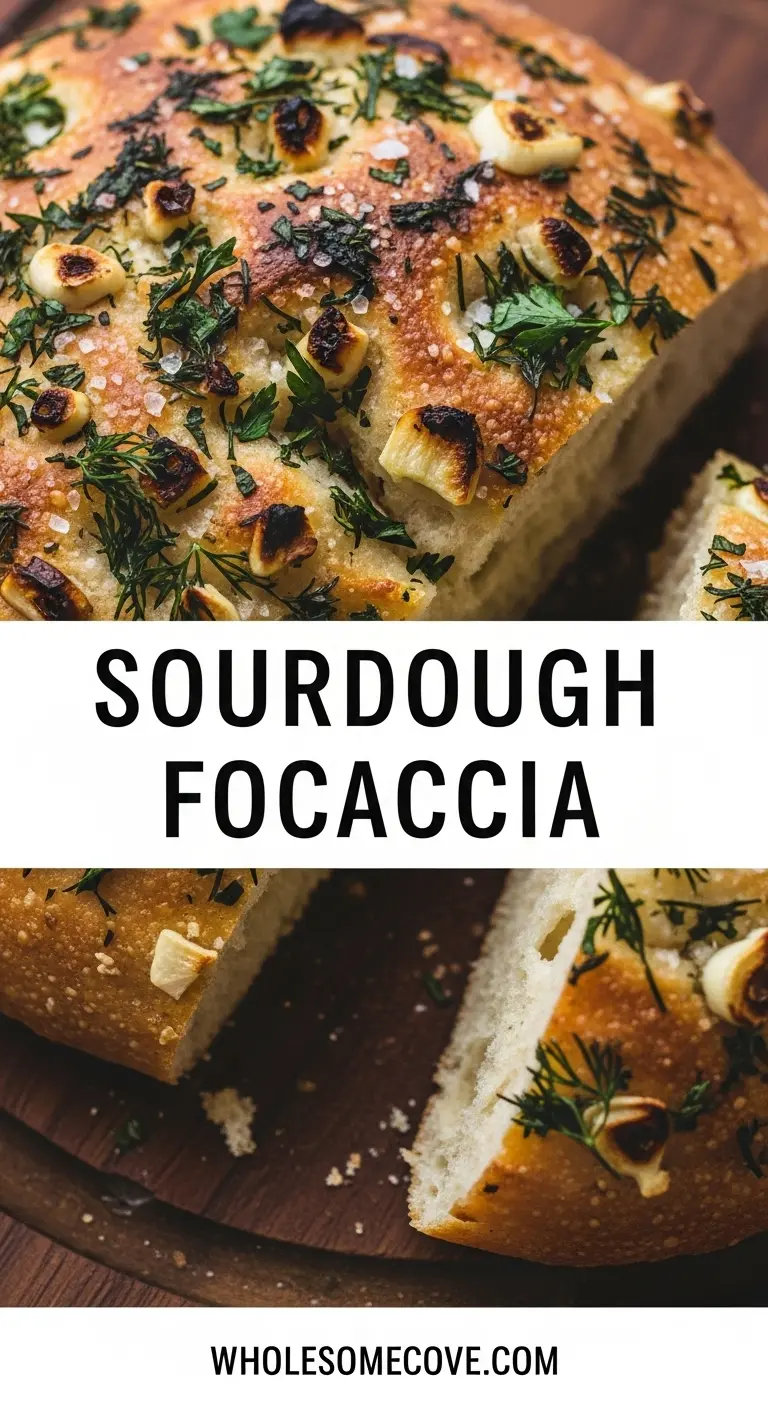
FAQs About Sourdough Focaccia
1. Can I use sourdough discard instead of active starter?
Absolutely! Using unfed sourdough discard is a fantastic way to reduce waste. However, since discard is less active than fed starter, your fermentation time will be longer. Plan for 10-12 hours at room temperature instead of 6-8 hours. The flavor will be just as delicious, maybe even slightly more tangy.
2. Why is my focaccia dense instead of airy?
Dense focaccia usually results from under-fermentation or over-handling the dough. Make sure your starter is active and bubbly, give the dough enough time to ferment (it should nearly double in size), and be gentle when transferring it to the pan. Also, don’t skip the stretch and folds during bulk fermentation as they build the gluten structure needed for those air pockets.
3. Can I make this focaccia in a different size pan?
Yes, you can adapt this recipe to different pan sizes. For a thicker focaccia, use a smaller 8×8 or 9×9 inch pan and increase baking time by 5-10 minutes. For thinner, crispier focaccia, use a larger sheet pan. Just make sure to adjust the amount of olive oil accordingly to coat your chosen pan.
4. How do I know when my dough has fermented enough?
Your dough should roughly double in size, feel airy and jiggly when you shake the bowl, and show visible bubbles throughout. If you gently press a finger into the dough, it should spring back slowly but leave a slight indentation. Over-fermented dough will be overly slack, smell strongly alcoholic, and may collapse when handled.
5. Can I prepare the dough the night before and bake it in the morning?
This is actually my preferred method! After mixing the dough and doing the stretch and folds, place it in the refrigerator for 8-12 hours overnight. The next morning, take it out, let it come to room temperature for 30-60 minutes, then proceed with shaping and the final proof. The cold fermentation develops even more complex flavors.
Read Also: Starbucks Banana Bread Recipe
Final Thoughts
This sourdough focaccia recipe has become one of my most-loved and most-shared recipes. There’s something magical about transforming simple ingredients and your sourdough starter into this golden, dimpled beauty.
The best part is how forgiving and flexible this recipe is. You can make it fit your schedule, customize it endlessly with toppings, and it works beautifully whether you’re a sourdough novice or an experienced baker.
I hope this recipe brings as much joy to your kitchen as it has to mine. Give it a try this weekend and let me know how it turns out! Drop a comment below with your favorite topping combinations or any questions you have.
Recommended:
- Jiffy Spoon Bread Recipe
- Snickerdoodle Banana Bread Recipe
- Chocolate Chip Bread Recipe
- Old Fashioned Pumpkin Bread Recipe
- Sweet Potato Bread Recipe
- Vasilopita Bread Recipe
- Air Fryer Banana Bread Recipe
- Easy Banana Bread Recipe
- Keto Banana Bread Recipe
- Banana Bread Recipe With No Eggs

